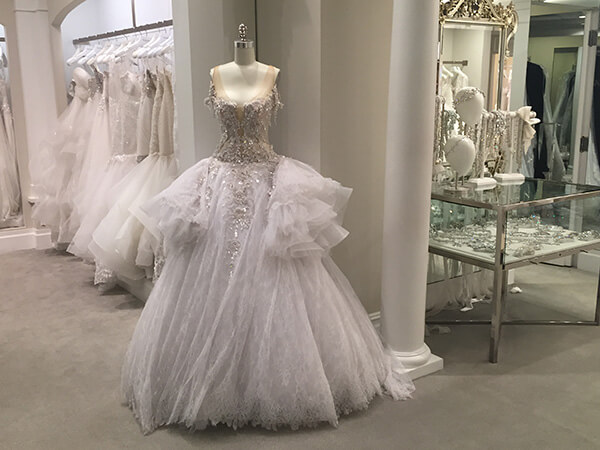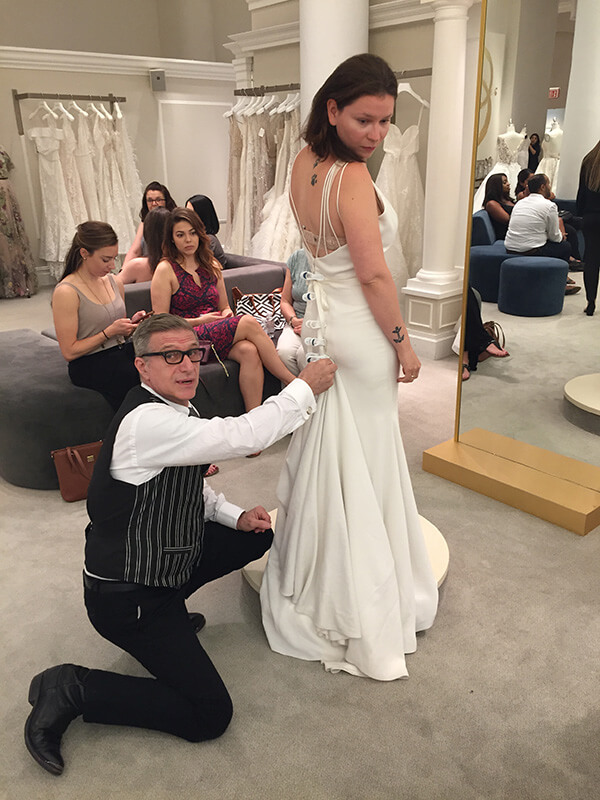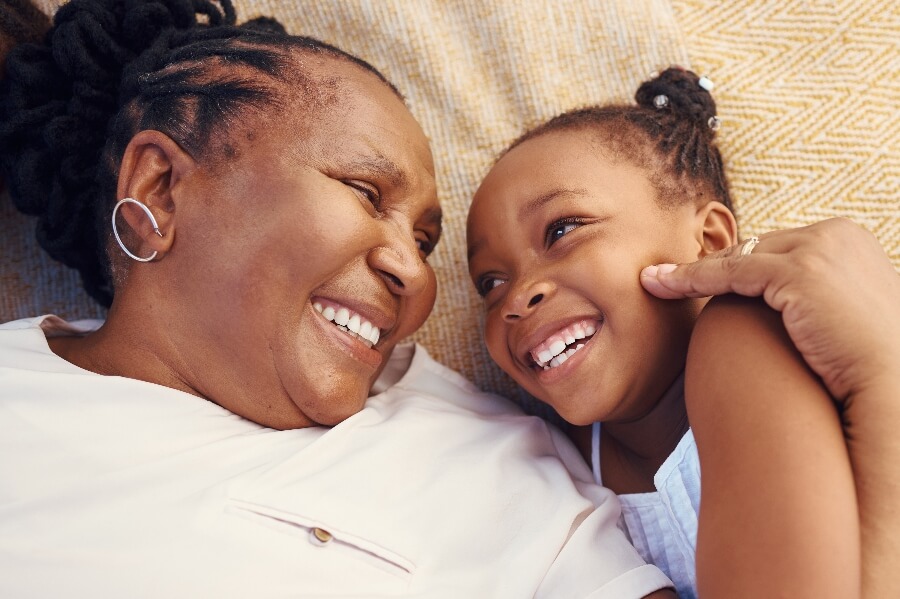If you are the mother of a bride, a soon to be mother-in-law, the bride herself, or in any way connected to the lead up to a wedding, it’s all but guaranteed that you have watched episodes of TLC’s series Say Yes To The Dress, and you know that the show tapes at Kleinfeld Bridal, the house of lace, silk, crystal, beads, pearls, sequins, and dreams reflected in many mirrors, on West 20th Street in Manhattan. Yes, women are striving for more equality in the workplace, in commerce, politics, technology, and more, but inside the doors of Kleinfeld, a pause is taken to give glamour its due.
Different generations gather on curved settees to see women they love appear in strapless, backless, bowed or buttoned, sleek or full, shining, sparkling wedding dresses in styles too numerous to count. Stepping into this enormous glow with my daughter, a soon-to-be bride, I surrendered to the trills of delight emanating from the mothers, grandmothers, sisters, and future brides, and in no time fell for the gossamer veils, the bling of jewelry, belts, and shoes. Who created all this? I asked myself. And then I met her.
I don’t ever look at anything as work!
What I noticed first when I sat across from Mara Urshel, the 79-year-old president/co-owner of Kleinfeld Bridal, is the fuchsia streaks in her short hair, a touch of rebel in a soft-spoken woman in black. We are in a utilitarian conference room in Kleinfeld Bridal, which belies the Narnia-like white world outside its doors. Urshel has been married twice in her life but has never worn a wedding dress. This is one of the ironies of the woman who, with her partner in business and life, Ron Rothstein, has produced what New York magazine describes as a “famous full-service salon (having) more designer bridal gowns than any other store in the world.” Its presence goes well beyond its street address because the popular television series Say Yes To The Dress, now in its 17th season in the USA and aired in over 150 countries, has given Kleinfeld international renown, even though it was not unknown before.
Well before Mara Urshel, the Kleinfeld name had a signature reputation rooted in Bay Ridge, Brooklyn. Getting a wedding dress at Kleinfeld seemed a rite of passage from the 1960s until the ‘90s, when future brides and their mothers stood outside waiting for the store to open, and hundreds of women made the pilgrimage to Brooklyn to compete, frequently physically, for a dream wedding dress at the annual sale.
Yet by 1999, Kleinfeld had changed hands twice and was on the brink of extinction. How Urshel brought Kleinfeld to a glory beyond any fame it might have once had is a tale of female determination that started at birth in Latvia and evolved through life experiences. Having escaped Eastern Europe, Urshel grew up to become an arbiter of style for brides around the globe, for how they look and feel. Hers is a story not just of immigration but of entrepreneurial drive at a time when to reach the top of any business, women had to excavate the roadways themselves. Now, at age 79, with personal instinct still her most trusted guide, Urshel presides over a multimillion-dollar business that continues to imprint the culture.
Her journey to creativity, however, was not direct. What has governed her life is a self-understanding that “I don’t ever look at anything as work, because there’s no time that I don’t give myself to whatever it is that I’m doing.”
The Long Road to America

Mara Urshel.
Her deeply rooted belief that she has to love what she is doing or not do it at all comes from a desire to avoid the frustration she saw in her parents as they struggled in jobs well below their educational levels to keep the family solvent. In Latvia her mother was a university professor and her father was president of the Bank of Riga. But with her parents, brother, sister, and two other family members, Urshel escaped after nightfall from the Soviets during WWII. It was 1942, and she was three years old and owned only the toddler clothes she was wearing upon her arrival in Germany. The family fled without assets and continued to have nothing during the seven years they lived in a refugee camp while her mother held out for the chance to relocate to America.
With her parents and other family members, Urshel escaped after nightfall from the Soviets during WWII.
Eventually, the American Federation of Lutheran Churches sponsored her family and settled them in Michigan, where her father was employed in the operations of a bakery and her mother cleaned houses, although later on she became a comptometrist (a bookkeeper/accountant who operates a machine called a comptometer). Her hardworking parents encouraged practicality, and Urshel graduated from the University of Michigan with a degree in biochemistry. What they didn’t expect is that one day between classes, while wearing a Jonathan Logan white knit dress embroidered with little pink rosebuds, she would break with family tradition and marry another student in a quick ceremony. “I had it (the Jonathan Logan dress) on for less than an hour because I got married in Ann Arbor City Hall, and I had class right after,” she recalls. “He was going to be a nuclear physicist and I was going to be Madame Curie.”
From Chemistry to Couture

One of the many sumptuous dresses at Kleinfeld Bridal. Image: Courtesy of the author
Urshel initially stayed in a scientific field, becoming a senior chemist at a large pharmaceutical company in Chicago and then working on cancer research projects at the National Institutes of Health (NIH) in Washington DC. (Her name appears on a number of scientific papers in the 1960s.) Biochemistry would not normally be considered a stepping stone for a career in fashion, but Urshel managed to pull that off. Constricted by the factual world of science, she decided to enjoy herself with an after-work job, selling couture dresses at Lord & Taylor. She became the scientist in a dress shop!
After serendipitously attending an evening seminar on fashion, she sought out a panel speaker who happened to be the president of tony Garfinckel’s Department store in DC. When he offered her a job, she got a divorce from her scientific career path and her husband. At age 25, she became a single woman, director of her own future. “I didn’t ask what the job was, I just wanted to be there,” says Urshel, wryly adding, “The worst part was I didn’t ask how much money I was going to make and I took a 75 percent cut in salary.” She moved from a clerical position to a buyer within three years, helped by the fact that her instincts about what women would want to wear profited the company.
I didn’t ask how much money I’d make and took a 75 percent salary cut!
When she married again, it was in a New York City apartment, to a man in her fashion world, Richard Kitt, president of a knitwear company. Once more, no-frills Urshel did not wear a wedding dress. “I wore a little white silk suit with a pleated skirt.” She and her new husband were establishing themselves as New Yorkers. A major touchstone in Urshel’s life is her 20 years at Saks Fifth Avenue, where she was the first woman to become vice president and then senior vice president: “I was in charge of over $500 million of the company.” All while she was helping to raise her three stepchildren, and not flagging when, after 15 years of marriage, her husband passed away.
Kleinfeld Bridal would likely have become merely a footnote in New York history if Urshel had not changed that trajectory after she changed her own, leaving Saks in 1992. “I think I got hit in the head after being in the corporate world for 20 years. All the time you can say you’re entrepreneurial but you’re not entrepreneurial until you’re on your own and you can’t call 5000 people to do your beck and call.”
Becoming the Bridal Queen

The author’s daughter getting fitted for her wedding dress at Kleinfeld Bridal. Image: Courtesy of the author
Post-Saks, she helped stimulate the Casual Corner label, and due to her reputation for brand-building, she was contacted in 1999 by Gordon Brothers investor/liquidators to assist in restoring something of Kleinfeld’s so that the business, which was going under, could be sold. “I gave them a plan and they said ‘It’s too much money.’” She went home and said to partner Ron Rothstein, a man she had met a little over a year after her husband had died, “I think I want to buy this company. I just felt the name was great, iconic. I thought, that is what you buy, something that is already there. … Gordon Brothers was holding out for more money but we wouldn’t budge. If they hadn’t signed on June 9,1999, they would have closed the doors the next morning. There would have been no Kleinfeld.” But sign they did. What Urshel and Rothstein bought (investing with the late Wayne Rogers, who famously portrayed “Trapper John” on the CBS television series M*A*S*H, and one other short-term investor) was in shambles. She remembers how “the basement leaked and many times I was up to my ankles trying to lift the dresses so they wouldn’t get ruined.” With the rundown conditions and difficult location, it became clear to Urshel and Rothstein that they had to move Kleinfeld out of Brooklyn.
“Because I was involved with Saks in designing our stores and working with the architects, I had an image of what I wanted Kleinfeld to be, which was not a retail store, it was more like a hotel,” says this woman of vision. And entering the Manhattan portals of Kleinfeld Bridal today does feel like walking into a luxury hotel with a sweeping silver, marble-topped reception desk stationed in front of ivory walls, strategically placed tall white orchid plants, and comfy sofas. It’s the wedding waiting room. At a time when David’s Bridal has filed for bankruptcy, Kleinfeld—with its NYC headquarters of 35,000 square feet, 250 employees, 75 designers, and more than 1500 wedding dresses on the premises—is thriving. Invisible to the future brides saying yes to their dresses are the more than 100 employees on a lower floor sewing, beading, and pressing those dresses. Together, Urshel and Rothstein have also expanded Kleinfeld’s reach beyond wedding dresses to invitations, jewelry, shoes, and hotel bookings.
Urshel knows what a wedding dress should be even though she never wore one.
Although today it’s possible to buy a wedding dress online, it’s not the same as slipping into something stunning with the help of a Kleinfeld associate. Urshel also makes a point of keeping individual attention high by making sure that brides have both her and Rothstein’s cell-phone numbers. That primary focus on the woman who is going to experience one of the most important days of her life comes across in the TV show. The series draws you in as you see the bride, her friends, and family all wrangling this most important decision. I have seen dozens of episodes of Say Yes To The Dress with my daughter, Masha, and like the father I met who came from Ghana to be with his daughter at Kleinfeld, I was there to be present when the big decision was made. I marveled at the layers of sparkle and shine, gathered under the guidance of Urshel, who has the gift of knowing what a wedding dress should be even though she never wore one herself.
As I watched my husband walk Masha down the aisle on her wedding day, I looked at the sleek, silky V-plunge dress she had chosen. It had many round, silk-covered buttons down the back, just like her beloved late grandmother’s dress did. I knew I would carry with me forever the memory of the first time she tried that dress on in Kleinfeld. I had gasped at the sight of those buttons, and Masha had looked at me and whispered “I know,” as both of us tried to manage our tears and smiles and hugs. Such a mix of emotions. She looked so grown-up and glorious, and now Masha was making her own history in a wedding dress that bore her signature nod to the past and elegant embrace of a future. A Big Yes, because Yes, a wedding dress is able to do all that! It becomes you—and you become it.
***
Eileen Stukane is a reporter for Chelsea Now, a New York City community newspaper. She is also the author of Running on Two Different Tracks, an ebook memoir. Eileen investigated women’s health issues while working as a writer on the staffs of Good Housekeeping, Cosmopolitan and Self magazines, and then became the co-author of four women’s health books, and the author of The Dream Worlds of Pregnancy. Her “Healthy Eating” column appeared in Food & Wine magazine for eight years. Every day she continues to delve into quality of life issues as a writer and reporter.




















0 Comments